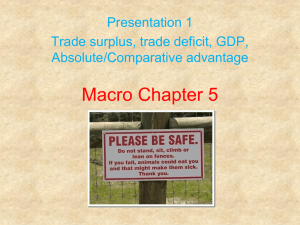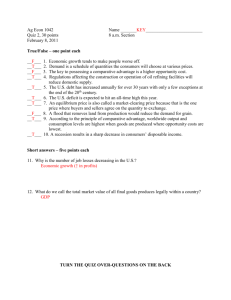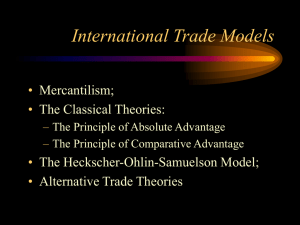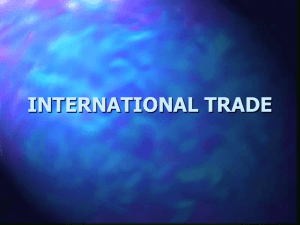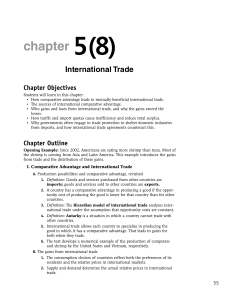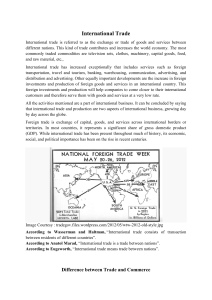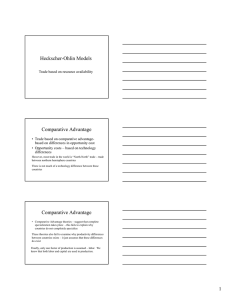Some Basics of International Trade
advertisement
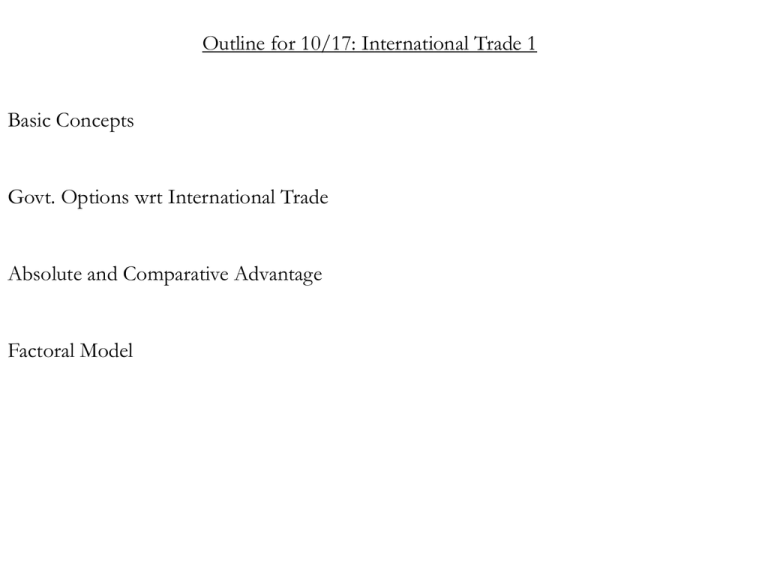
Outline for 10/17: International Trade 1 Basic Concepts Govt. Options wrt International Trade Absolute and Comparative Advantage Factoral Model Some Basics of International Trade Definition – exchanges of goods/services across national borders Actors – Corporations and Governments Exports (X) – Goods out Money in Imports (I) – Money out Goods in Trade Deficit X<M Trade Surplus X>M Country with trade deficit? County with trade surplus? More Basics of International Trade Current Account – keeps track of exports and imports exports are a credit and imports are a debit Capital Account – keeps track of other financial flows in/out of a national economy inward investments are a credit and outward investments are a debit A Current Account Deficit must be offset by Capital Account Surplus What is US situation in terms of its current and capital accounts? Government Options wrt International Trade Autarky Laissez-faire (free trade) Forms of trade protection Restrictions on Imports: Tariffs Quotas Product standards Mechanisms to promote exports: Subsidies Undervalued currency Dumping What are the costs of trade protection? Why do governments nonetheless often choose to protect/close their markets? Comparative vs. Absolute Advantage Absolute advantage in production – compares two countries in terms of one product a country has an absolute advantage if it can produce more of a given product (or produce it at lower cost) than another country. Comparative advantage in production – compares two countries in terms of two different products a country has a comparative advantage in a particular product when its opportunity cost for producing that product is lower than another country’s. Differences in comparative advantage create the basis for international trade countries should produce only their comparative advantage products, sell the surplus to other countries, and use the profits to buy other products in which they lack comparative advantage. Example 2 countries (USA and Ghana) and 2 products (food and movies) If all production If all production devoted to food devoted to movies USA 400 100 Ghana 100 10 400 350 Ghana USA 300 food 250 200 150 100 50 0 0 10 20 30 40 50 movies 60 70 80 90 100 How do we know in what kinds of products a country has comparative advantage? Look at factors of production 4 factor model: Land/natural resources (R) Labor (L) Capital (K) Human capital (HK) Different countries have different endowments in terms of these 4 factors Abundant factors – those that are well-supplied, can be obtained at low cost. Scarce factors – those that not well-supplied, can only be obtained at high cost Country United States EU, Japan Most LDCs India, China Abundant factors Scarce factors Country Abundant factors Scarce factors United States R, K, HK L EU, Japan K, HK L, R Most LDCs R, L K, HK India, China R, L, HK K What kinds of products require lots of land/natural resources (R) and labor (L)? What countries should produce them? Who should not? What kinds of products require lots of capital (K) and human capital (HK)? What countries should produce them? Who should not? Country Abundant factors Scarce factors United States R, K, HK L EU, Japan K, HK L, R Most LDCs R, L K, HK India, China R, L, HK K This factor model explains a lot about international trade 1. Which producers (in which countries) benefit from international trade and which producers (in which countries) are harmed by international trade 2. Why the United States tends to favor free trade 3. Divisions in the current Doha round of international trade negotiations between developed and developing countries
